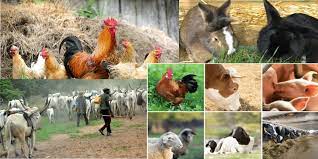
The Imperatives of Livestock Empowerment for Rural Women
By Hadiza Yusuf Ahmad
Ensuring social security benefits for citizens is one of the fundamental ways to maintain a stable and productive society. This can be effectively achieved by providing job opportunities through viable empowerment initiatives tailored to the needs of the people.
A prime example is the livestock empowerment program launched by former Governor Muhammad Badaru Abubakar of Jigawa State in 2016. This initiative, which distributed goats to hundreds of women, was designed to provide them with a sustainable source of income.
The results were remarkable. One beneficiary from a village in Dutse transformed this modest start into a flourishing venture. She recounted her journey, stating that she started with three goats and eventually expanded to ten.
She occasionally sells a goat to support her family and, interestingly, even civil servants come to her for financial assistance. Looking ahead, she envisions herself as a successful goat farmer. Her success story reflects the broader impact of the program, where women not only embraced the initiative but thrived because it aligned with their traditional skills and economic realities.
As Kano State faces criticism over its recent livestock empowerment program, lessons from Governor Badaru’s initiative offer valuable insights. Practical empowerment programs that align with the skills and experiences of rural women can yield far-reaching benefits.
While technology-driven initiatives are important, they often fail to address the immediate economic needs of rural communities.
Empowerment is most effective when it resonates with the beneficiaries’ skills, interests, and realities. The recent goat distribution program for rural women exemplifies this approach. Goats are familiar assets in these communities, and the women already possess the knowledge and experience needed to rear and manage them.
This familiarity was evident in the excitement and gratitude expressed by the beneficiaries. Such initiatives not only provide economic empowerment but also build on existing expertise, ensuring sustainability and long-term impact.
Avoiding Misplaced Priorities in Empowerment Programs
Just like the livestock empowerment initiatives in Jigawa and Kano, empowerment programs should be designed based on the skills and realities of the target beneficiaries. Misplaced priorities can lead to wasted resources and failed interventions.
For instance, empowering rural women with advanced technology in the name of modernity often proves ineffective. Many rural areas lack the necessary infrastructure, such as internet access or ICT support systems, and the beneficiaries often have no prior experience with digital tools.
A case in point is the N-Power program, where ICT devices were distributed to individuals with little or no knowledge of their use. Many recipients ended up selling the devices at very low prices simply because they did not understand their value or how to utilize them effectively.
Similarly, past agricultural empowerment programs have distributed farming tools to individuals who lacked the skills or interest to use them. Many beneficiaries ultimately sold the equipment at a fraction of its value, rendering the intervention ineffective. These examples highlight a crucial lesson. For empowerment programs to succeed, they must be designed with a deep understanding of the community’s background, skills, and economic realities.
Why Livestock Empowerment Works
The success of goat distribution programs underscores this principle. Livestock empowerment has proven to be a practical and sustainable strategy for rural women, who are accustomed to rearing animals. They not only cherish the goats but also leverage them to generate steady income through milk sales, breeding, and livestock trading. This approach contrasts sharply with empowerment strategies that introduce unfamiliar tools or resources, which often fail due to a lack of knowledge or interest among the beneficiaries.
Effective empowerment begins with listening to the beneficiaries, understanding their realities, and equipping them with tools they can confidently use. Only then can true, lasting empowerment take root and flourish.
The Multifaceted Benefits of Goat Rearing
Beyond its economic potential, goat farming offers numerous other benefits to rural communities. According to a female farmer who shared insights anonymously, goat milk is highly nutritious and serves multiple purposes.
“Some people drink it like regular cow milk because of its nutritional value, while others use it medicinally or even as an aphrodisiac,” she explained. This versatility makes goat milk a sought-after product, further boosting the income of women engaged in goat farming.
The farmer also emphasized how goat rearing enhances economic resilience for rural women. “A goat is an asset that only those who understand its value truly appreciate,” she noted. Women often sell goats to meet financial needs during emergencies, making livestock farming a reliable economic buffer.
Additionally, goat farming stimulates local economies, as farmers purchase feed, such as chaff and other goat meals, from other women, creating a ripple effect of economic activity.
Another farmer highlighted the environmental benefits of goat farming, particularly in agriculture. Goat waste serves as a natural fertilizer, which is sold for as much as ₦6,000 per bag, offering an additional source of income. Some farmers even rear goats on their farmland before planting, allowing the animals’ waste to naturally enrich the soil, leading to better farm yields.
Sharing his personal experience, the farmer concluded: “I take goat milk myself because it’s medicinal. Beyond the milk and meat, goats support both economic and agricultural productivity, making them an indispensable resource for rural communities.”
Conclusion
These insights demonstrate the transformative potential of goat farming for rural women. From nutrition and income generation to sustainable farming practices, livestock empowerment stands out as an effective, practical, and culturally relevant strategy for improving livelihoods.
If empowerment programs are to succeed, they must be designed with a clear understanding of the needs, skills, and socio-economic realities of the beneficiaries. When people are provided with tools they understand and can use effectively, they are more likely to embrace the initiative, creating a pathway for long-term success and self-sufficiency.
Hadiza Yusuf Ahmad is a PRNigeria Fellow (2024). She writes from Kano and can be reached at [email protected]
